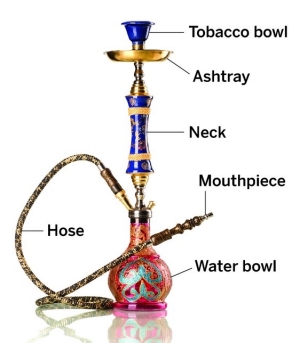What’s hookah, and is it healthier than smoking a cigarette?
Many people think that water pipe smoking, a growing trend around the Globe, is a risk-free way to get a nicotine fix

It’s a tobacco smoking style with many names: hookah, shisha, narghile, goza, and hubble-bubble, to name a few. Invented in India in the 15th century, water-pipe smoking has long been popular in the Middle East. Yet over the past decade, smoking hookah has also become trendy in the U.S., particularly on college campuses and among high school students. Today, an estimated 100 million people worldwide smoke water pipes, with many users mistakenly believing that it is a risk-free way to consume tobacco.
Part of the appeal is the exotic device, which is typically ornately decorated yet has a simple design. A bowl at the top of the water pipe holds a sticky mixture of tobacco, honey, molasses, fruit pulp, and/or flavorings as diverse as mint, coconut, peach, and even cola. Crushed tobacco leaves, typically present at about 5–10% in the mixture, look like little flakes in the jamlike paste, says Peyton Jacob, who studies water-pipe chemistry at the University of California, San Francisco.
Smokers place a piece of perforated aluminum foil above the tobacco paste and then add a cube of burning charcoal on top, which chars the tobacco through the foil to produce smoke. The smoke travels through the body of the water pipe, called the stem or neck, and collects above the water in a chamber at the bottom of the device. To inhale, hookah enthusiasts suck on a mouthpiece that is attached by a hose to the water chamber, so that the smoke bubbles through the liquid and then into their lungs.
“One of the biggest misconceptions about hookah smoking is that the water filters out the toxic substances found in the smoke,” Jacob says. According to hookah legend, this was precisely the device’s selling point used by the 15th-century Indian doctor who invented it. But “it’s just not true,” Jacob adds.
If the pipe’s water is filtering out any of the harmful chemicals in hookah smoke, it is doing so in nearly negligible amounts. That includes many carcinogens, as well as nicotine, which is normally prone to dissolving in water, Jacob says. At a maximum, the water chamber filters out 5% of the nicotine, leaving users with 95% exposure to the addictive compound. As a rule of thumb, an hour-long session of smoking hookah gives users a dose of nicotine similar to smoking two to three cigarettes, Jacob says.
Jacob points out that there are many differences in how cigarette and hookah tobacco is produced, cooked, and consumed. For example, water-pipe tobacco smolders at 450 °C, whereas cigarette tobacco, which is lit on fire, burns at 900 °C, leading to variation in their smoke chemistry. Despite the differences between cigarette and hookah smoking, however, “you get delivery of the same toxic chemicals to the body—just in different ratios,” Jacob says.
For example, the smoldering charcoal used to char the hookah tobacco produces much more carbon monoxide—a colorless, odorless gas that is an asphyxiant and can lead to heart disease. It also produces more of some polyaromatic hydrocarbons—many of which are carcinogens or suspected carcinogens—than a burning cigarette does.
A number of other toxic compounds found in cigarette smoke are also produced in hookah smoke, including nitrosamines, benzene, hydrogen cyanide, and formaldehyde. Sometimes these compounds are present at lower levels than in cigarette smoke, sometimes at higher levels.
Even though researchers have been measuring chemicals of concern in hookah smoke for a long time, critics have argued that these chemicals do not find their way into the human body. But in 2009, Jacob and colleagues started comparing the urine of hookah smokers and cigarette smokers. The scientists found that “these individuals were exposed to the same toxic substances but in different amounts,” Jacob says.
Additionally, several studies have shown that toxic heavy metals are also present in hookah smoke, including chromium, arsenic, and lead, although the levels vary significantly from brand to brand of hookah tobacco (Curr. Probl. Pediatr. Adolesc. Health Care 2011, DOI: 10.1016/j.cppeds.2010.10.001).
Water-pipe tobacco is not currently regulated by the Food & Drug Administration, although this is expected to change later this summer, when hookah tobacco is scheduled to be regulated through the same law that governs cigarettes.
Despite the health risks of hookah smoking, the practice is on the rise. A 2015 Centers for Disease Control & Prevention study found that water-pipe use nearly doubled among high school students between 2013 and 2014, from 5.2% to 9.4%, or from approximately 700,000 to 1.3 million students. These and other studies warn that young people are drawn by the fruity flavors; the exotic novelty; the social atmosphere of hookah cafes, where the mouthpiece is passed around in a circle of friends; and the misconception that hookah smoking has a low health risk.
But considering the kinds of toxic chemicals lurking within that sweet-smelling smoke, getting hooked on hookah may not be so attractive after all.
source : https://amanmaloo.blogspot.com/2017/08/whats-hookah-and-is-it-healthier-than.html